24-Frame Playback, from Patriot Games to Deja Vu and MI: 4

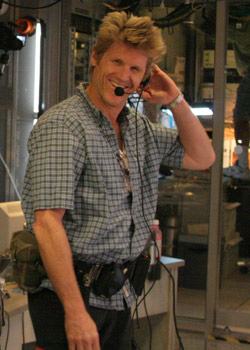
Monte Swann
Thinking of President Obama watching live video of the raid that killed Osama Bin Laden, I can’t help but be reminded of a scene from the 1992 film Patriot Games where Jack Ryan (Harrison Ford) is invited into the inner workings of the CIA’s top-secret war room to witness a covert military strike on a training camp in Libya. Illuminated predominantly by large video screens surrounding the room, the scene is eerie and somber as, one by one, the camp’s inhabitants are attacked and killed by SAS strike teams while Ryan looks on through a live satellite feed.
Perhaps if Osama bin Laden had a subscription to Netflix he might have seen what was coming. Sure, spy technology is far more advanced today, but this scene was shot more than 19 years ago. The technology depicted in the film is fictitious, but the similarities to current scenarios are striking. The main focus of this scene is not on the actors but on the realistic images that unfold on the video screens. How does all that imagery end up on those screens, and who’s responsible for it?
It’s a process known as 24-frame video playback, and it has changed little since it was introduced in the late 1970’s. The 24-frame process is done live on set, not in post. Before the introduction of flat-screen LCD technology, all TVs utilized CRT (cathode ray tube) technology – the big, heavy ones that your parents had in their living room. Standard 30-frame video devices had to be converted to operate at 24 frames per second, the standard for motion pictures, with everything frame-locked together. Otherwise, a rolling black bar or other annoying flutter would appear on the film.
Patriot Games
I have made my living with this specialized service for over 25 years – on Patriot Games, as the supervising engineer. This is basically a spy movie and, on a film like this, the video department is involved with pre-production long before principal photography begins. The live satellite POV effect was achieved by mounting a 35mm film camera to a helicopter hovering high above the action – which, by the way, was staged during a bright sunny day. The tents were constructed of a transparent scrim-like material to create the see-through effect. Then, VFX artists at Video Image, where I worked at the time, added the blue heat-signature effect to the film. All of this was transferred to videotape and delivered to the set for playback.
It’s 6 p.m. and the war room scene is scheduled to shoot the following morning, but you’d never guess by looking. The crew is swarming over the set like bees on a honeycomb, applying last-minute touches. Construction is still hammering and sawing while the painters are trying, in vain, to touch everything up. Set dressing is tending to the personal touches like pencils, post-its, and other tchotchkes. The electricians are adjusting lights and the grips are doing almost everything else. The video department has built a fortress out of road cases, and cables run out of it in all directions. Our playback sources are ¾-inch U-matic VCRs, so the equipment cases are pretty big. We have to feed three large video projectors and several video monitors on set. You’d swear we were loading in for a Pink Floyd concert or something.
Late that night, when all the other departments are done tweaking, we finally have the set. We turn off the stage lights so we can do our color-correction and set the exposure, but the finished videotapes are just arriving on set. The tapes are cued up and, one by one, the images slowly appear on the screens. It’s going to be a long night.
Deja Vu
The playback process is more streamlined today but still very similar. Let’s jump ahead to 2006. We have just come through the time window of Deja Vu. It’s 6 p.m. and the scene is scheduled to shoot the following morning, but you’d never guess by looking. The crew is swarming over the set, like bees, applying last-minute touches. Soon, the time machine will literally catch up to us.
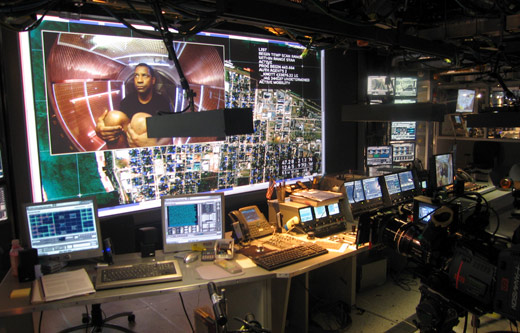
The time window: Deja Vu, 2006. Courtesy Cygnet Video.
Although Denzel Washington gets primary billing, the massive time window is the star of this scene. A large rear-projection screen, three times larger than the ones we used on Patriot Games, takes up the entire back wall of the set. For several days, we have been loading in a formidable video command center. Cables still snake out in all directions like spilled pasta, but these are much larger and thicker than their predecessors, enabling high-frequency computer signals to be transmitted over 100 feet to the set.
The projectors we’re using are two super-bright HD monsters putting out 12,000 lumens each – 20 times brighter than the ones used on Patriot Games. One projector fills in the background element, a patchwork of surveillance images we shot over the previous few months in New Orleans. The other one projects the hero (story-point) elements into the center portion of the screen in full uncompressed HD.
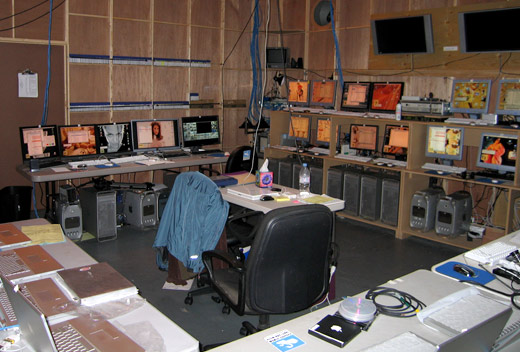
Video village: Deja Vu. Courtesy Cygnet Video.
The days of videotape are long gone. Now, the playback originates on hard drives. More than 40 of them are needed to fill all the screens on this set. In fact, it takes two custom-built video rooms just to accommodate all of equipment. Our main control room, called “video village,” was built to accommodate an eight-man playback crew, including three graphic artists, three playback operators, a coordinator, and myself. Just outside this room is our video command center, which processes and routes all the feeds to the background projector.
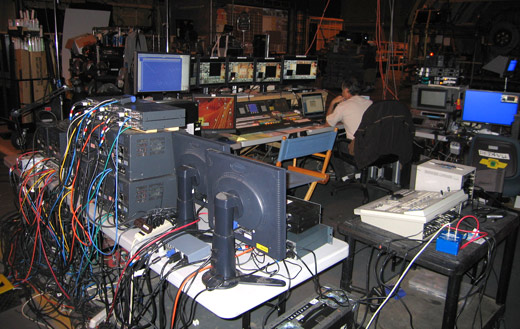
The video command center, Deja Vu. Courtesy Cygnet Video.
It’s been almost 20 years since Patriot Games, and you’d think the new technology would make things a lot easier, but that’s not always the case. Everything we use to recreate Deja Vu‘s time-travel control room is based on the latest cutting-edge technology, including the Panavision Genesis camera used to shoot the scene, but we still encounter some of the same old problems. Unlike LCD technology, DLP projectors use an array of pivoting mirrors to achieve their ultra bright high-resolution images, and these can cause shutter artifacts when photographed at 24fps. Sure enough, after watching dailies, we detect a slight fluttering artifact on the big screen. That means everything has to be frame-locked together, just like in the old days.
Mission Impossible: Ghost Protocol
Moving forward to the present day, we find ourselves behind the bars of an old prison just outside Prague, in the Czech Republic. We’re standing in a long-neglected semi-circular concrete room located in the center of a crumbling old cellblock. In sharp contrast to this stark environment are the carts of high-tech computer equipment surrounding us.
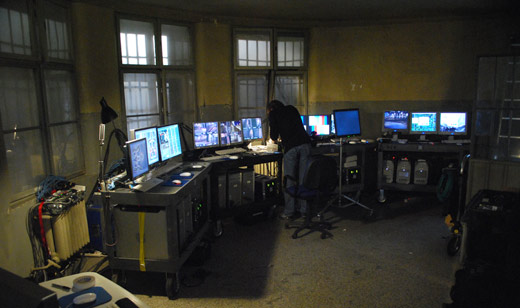
Video village: Mission: Impossible – Ghost Protocol, 2011. Courtesy Cygnet Video.
We’ve commandeered this space to set up our video village for the latest installment of the popular Tom Cruise Mission Impossible franchise, Ghost Protocol. A mass of cables spills through the bars and drops down two floors to where the action takes place. For this scene, we’re recreating a state-of-the-art prison surveillance room. We’ve been lugging all this gear up three flights of narrow concrete steps over the last few days, and now we’re running around the prison picking up surveillance shots.
We still use a lot of cable, but now it’s ultra-thin, lightweight Cat5, a big improvement over the garden-hose VGA cables we used on Deja Vu. We’re shooting all our footage on HD and capturing everything on Final Cut Pro. Turnaround time is almost non-existent, so we had to lug the whole edit bay up here, too.
The technology of movie making continues to transform every aspect of the business but the basic crafts still remain the same. Every movie requires hours of preparation and the cooperation of several specialized departments – just like the Joint Special Operations Command used to destroy Osama bin Laden and his al-Qaeda’s headquarters required the cooperation of many specialized military teams. Making a feature film is very much like undertaking a large-scale military operation. The difference, of course, is that with a movie, nobody’s going to die if you screw it up. You just do another take.
Monte Swann is the supervising engineer at Cygnet Video, a Los Angeles based Video Production facility. He is currently working on the latest Batman project, The Dark Knight Rises.
Crafts: Shooting
Sections: Creativity
Did you enjoy this article? Sign up to receive the StudioDaily Fix eletter containing the latest stories, including news, videos, interviews, reviews and more.









Leave a Reply